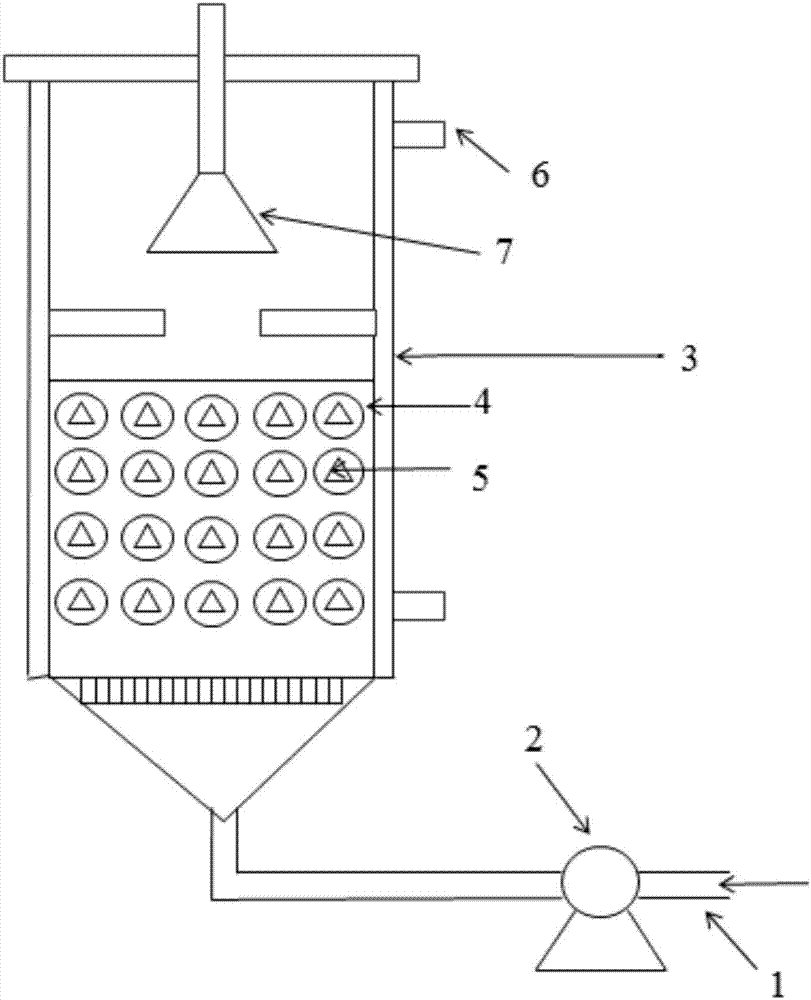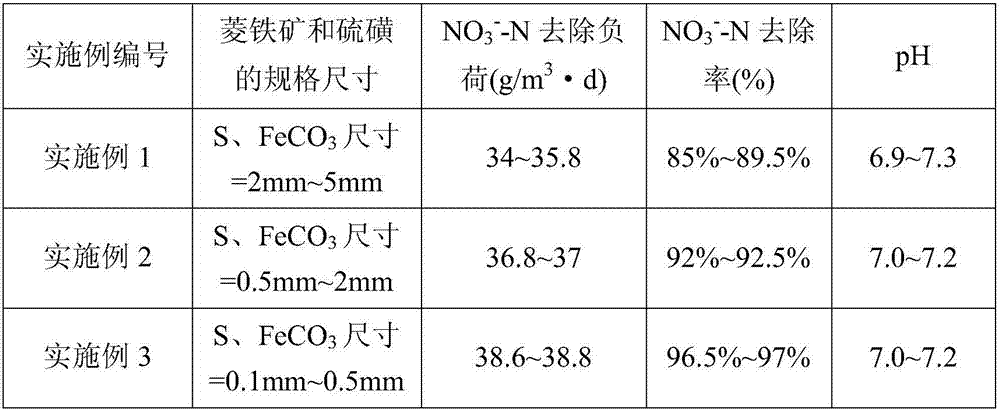Slow-release electron donor and method for advanced nitrogen removal of wastewater by applying slow-release electron donor
An electron donor, slow-release technology, applied in chemical instruments and methods, biological water/sewage treatment, water/sludge/sewage treatment, etc., can solve the problems of high effluent hardness, consumption of limestone, etc. The effect of small mud yield and easy engineering popularization and application
- Summary
- Abstract
- Description
- Claims
- Application Information
AI Technical Summary
Problems solved by technology
Method used
Image
Examples
Embodiment 1
[0042] This embodiment provides a slow-release electron donor and a method for deep denitrification of sewage by using it. The slow-release electron donor is a complex composed of siderite and sulfur at a volume ratio of 1:1. First, the surface of natural siderite is cleaned with 0.5% dilute hydrochloric acid, ground and crushed into particles with a diameter of 2mm to 5mm, and the surface of sulfur is also cleaned with 0.5% dilute hydrochloric acid, ground and crushed into particles with a diameter of 2mm to 5mm, and then Siderite granules and sulfur granules are uniformly mixed at a volume ratio of 1:1 before use.
[0043]Fill the microporous hollow sphere carrier with the above-mentioned slow-release electron donor to form a biofilter filler. The diameter of the microporous hollow sphere is 20mm, the mesh is 180 mesh, and the material is high-density polyethylene. The filling of the slow-release electron donor It is 90% proportioned and comes in a snap-seal package after f...
Embodiment 2
[0050] Embodiments 2 to 3 respectively provide a slow-release electron donor and a method for deep denitrification of sewage by using the same. Their operations are basically the same as those in Example 1, except that the specifications of sulfur and siderite in the slow-release electron donor are different. Wherein, the siderite and sulfur in embodiment 2 are all particles with a diameter of 0.5 mm to 2 mm, and the siderite and sulfur in embodiment 3 are all particles with a diameter of 0.1 mm to 0.5 mm. Embodiments 2 and 3 The processing result and the comparison with embodiment 1 processing result are as shown in table 1. It can be seen from Table 1 that the smaller the particles of siderite and sulfur, the better the denitrification effect and the higher the pH stability.
[0051] The denitrification effect in the embodiment 2~3 of table 1
[0052]
Embodiment 4
[0054] Embodiments 4 to 8 are also respectively a slow-release electron donor and a method for deep denitrification of sewage by using it. Their operations are basically the same as in Example 1, except that the compounding ratio of sulfur and siderite in the slow-release electron donor is different. Wherein, the slow-release electron donor in Example 4 is a compound composed of siderite and sulfur in a volume ratio of 1:2, and the slow-release electron donor in Example 5 is made of siderite and sulfur in a volume ratio 2:1 composition compound, the slow-release electron donor in embodiment 6 is the complex that is made up of siderite and sulfur by volume ratio 1:10, and the slow-release electron donor in embodiment 7 is made of siderite The complex composed of ore and sulfur at a volume ratio of 1:5, the slow-release electron donor in Example 8 is a complex composed of siderite and sulfur at a volume ratio of 5:1. The processing results of Examples 4-8 and the comparison wit...
PUM
| Property | Measurement | Unit |
|---|---|---|
| diameter | aaaaa | aaaaa |
| diameter | aaaaa | aaaaa |
| diameter | aaaaa | aaaaa |
Abstract
Description
Claims
Application Information
 Login to View More
Login to View More - Generate Ideas
- Intellectual Property
- Life Sciences
- Materials
- Tech Scout
- Unparalleled Data Quality
- Higher Quality Content
- 60% Fewer Hallucinations
Browse by: Latest US Patents, China's latest patents, Technical Efficacy Thesaurus, Application Domain, Technology Topic, Popular Technical Reports.
© 2025 PatSnap. All rights reserved.Legal|Privacy policy|Modern Slavery Act Transparency Statement|Sitemap|About US| Contact US: help@patsnap.com



